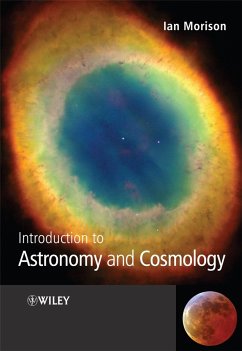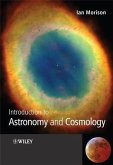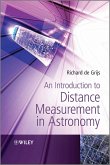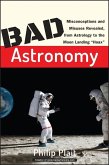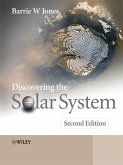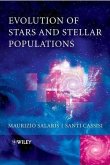Introduction to Astronomy and Cosmology (eBook, PDF)


Alle Infos zum eBook verschenken

Introduction to Astronomy and Cosmology (eBook, PDF)
- Format: PDF
- Merkliste
- Auf die Merkliste
- Bewerten Bewerten
- Teilen
- Produkt teilen
- Produkterinnerung
- Produkterinnerung

Hier können Sie sich einloggen

Bitte loggen Sie sich zunächst in Ihr Kundenkonto ein oder registrieren Sie sich bei bücher.de, um das eBook-Abo tolino select nutzen zu können.
Introduction to Astronomy & Cosmology is a modern undergraduate textbook, combining both the theory behind astronomy with the very latest developments. Written for science students, this book takes a carefully developed scientific approach to this dynamic subject. Every major concept is accompanied by a worked example with end of chapter problems to improve understanding * Includes coverage of the very latest developments such as double pulsars and the dark galaxy. * Beautifully illustrated in full colour throughout * Supplementary web site with many additional full colour images, content, and latest developments.…mehr
- Geräte: PC
- mit Kopierschutz
- eBook Hilfe
- Größe: 11.95MB
![Introduction to Astronomy and Cosmology (eBook, ePUB) Introduction to Astronomy and Cosmology (eBook, ePUB)]() Ian MorisonIntroduction to Astronomy and Cosmology (eBook, ePUB)42,99 €
Ian MorisonIntroduction to Astronomy and Cosmology (eBook, ePUB)42,99 €![An Introduction to Distance Measurement in Astronomy (eBook, PDF) An Introduction to Distance Measurement in Astronomy (eBook, PDF)]() Richard De GrijsAn Introduction to Distance Measurement in Astronomy (eBook, PDF)42,99 €
Richard De GrijsAn Introduction to Distance Measurement in Astronomy (eBook, PDF)42,99 €![Bad Astronomy (eBook, PDF) Bad Astronomy (eBook, PDF)]() Philip C. PlaitBad Astronomy (eBook, PDF)10,99 €
Philip C. PlaitBad Astronomy (eBook, PDF)10,99 €![Astrophysics (eBook, PDF) Astrophysics (eBook, PDF)]() Judith Ann IrwinAstrophysics (eBook, PDF)56,99 €
Judith Ann IrwinAstrophysics (eBook, PDF)56,99 €![Discovering the Solar System (eBook, PDF) Discovering the Solar System (eBook, PDF)]() Barrie W. JonesDiscovering the Solar System (eBook, PDF)58,99 €
Barrie W. JonesDiscovering the Solar System (eBook, PDF)58,99 €![Evolution of Stars and Stellar Populations (eBook, PDF) Evolution of Stars and Stellar Populations (eBook, PDF)]() Maurizio SalarisEvolution of Stars and Stellar Populations (eBook, PDF)60,99 €
Maurizio SalarisEvolution of Stars and Stellar Populations (eBook, PDF)60,99 €![Reviews in Modern Astronomy (eBook, PDF) Reviews in Modern Astronomy (eBook, PDF)]() Reviews in Modern Astronomy (eBook, PDF)183,99 €
Reviews in Modern Astronomy (eBook, PDF)183,99 €-
-
-
Dieser Download kann aus rechtlichen Gründen nur mit Rechnungsadresse in A, B, BG, CY, CZ, D, DK, EW, E, FIN, F, GR, HR, H, IRL, I, LT, L, LR, M, NL, PL, P, R, S, SLO, SK ausgeliefert werden.
- Produktdetails
- Verlag: John Wiley & Sons
- Seitenzahl: 360
- Erscheinungstermin: 20. November 2008
- Englisch
- ISBN-13: 9780470740194
- Artikelnr.: 37299192
- Verlag: John Wiley & Sons
- Seitenzahl: 360
- Erscheinungstermin: 20. November 2008
- Englisch
- ISBN-13: 9780470740194
- Artikelnr.: 37299192
Introduction. 1.2 Galileo Galilel's proof of the Copernican theory of the
solar system. 1.3 The celestial sphere and stellar magnitudes. 1.4 The
celestial coordinate system. 1.5 Precession. 1.6 Time. 1.7 A second major
observational triumph: the laws of planetary motion. 1.8 Measuring the
astronomical unit. 1.9 Isaac Newton and his Universal law of Gravity. 1.10
Experimental measurements of G, the Universal constant of gravitation. 1.11
Gravity today: Einstein's special and general theories of relativity. 1.12
Conclusion. 1.13 Questions. Chapter 2: Our Solar System 1 - The Sun. 2.1
The formation of the solar system. 2.2 The Sun. 2.3 Nuclear fusion. 2.4 The
solar neutrino problem. 2.5 The solar atmosphere: photosphere, chromosphere
and corona. 2.6 The solar wind. 2.7 The sun's magnetic field and the
sunspot cycle. 2.8 Prominences, flares and the interaction of the solar
wind with the earth's atmosphere. 2.9 Solar eclipses. 2.10 Questions.
Chapter 3: Our Solar System 2 - The Planets. 3.1 What is a planet? 3.2
Planetary orbits. 3.3 Planetary properties. 3.4 Planetary atmospheres. 3.5
The planets of the solar systems. 3.6 Comets. 3.7 Questions. Chapter 4:
Extra-solar Planets. 4.1 The radial velocity (Doppler wobble) method of
planetary detection. 4.2 Planetary transits. 4.3 Gravitational
microlensing. 4.4 Astrometry. 4.5 Discovery space. 4.6 Selection effects
and the likelihood of finding solar systems like ours. 4.7 Questions.
Chapter 5: Observing the Universe. 5.1 Thinking about optics in terms of
waves rather than rays. 5.2 The human eye. 5.3 The use of a telescope or
pair of binoculars to see fainter objects. 5.4 Using a telescope to see
more detail in an image. 5.5 The magnification of a telescope. 5.6 Image
Contrast. 5.7 The classic Newtonian telescope. 5.8 The Cassegrain
telescope. 5.9 Catadioptric telescopes. 5.10 Active and adaptive optics.
5.11 Some significant optical telescopes. 5.12 Radio telescopes. 5.13
Observing in other wavebands. 5.14 Observing the universe without using
electromagnetic radiation. 5.15 Questions. Chapter 6: The Properties of
Stars. 6.1 Stellar luminosity. 6.2 Stellar distances. 6.3 Proper motion.
6.4 The absolute magnitude scale. 6.5 Colour and surface temperature. 6.6
Stellar photometry. 6.7 Stellar spectra. 6.8 Spectroscopic parallax. 6.9
The Hertzsprung-Russell Diagram. 6.10 The size of stars. 6.11 The masses
and densities of stars. 6.12 The stellar mass-luminosity relationship. 6.13
Stellar lifetimes. 6.14 Questions. Chapter 7: Stellar Evolution - The Life
and Death of Stars. 7.1 Low mass stars: 0.05-0.5 solar masses. 7.2 Mid mass
stars: 0.5--8 solar masses. 7.3 Variable stars. 7.4 Planetary nebula. 7.5
White dwarfs. 7.6 The evolution of a sun-like star. 7.7 Evolution in close
binary systems - the Algol paradox. 7.8 High mass stars in the range >8
solar masses. 7.9 Type II supernova. 7.10 Neutron stars and black holes.
7.11 The discovery of pulsars. 7.12 Pulsars as tests for general
relativity. 7.13 Black holes. 7.14 Questions. Chapter 8: Galaxies and the
Large Scale Structure of the Universe. 8.1 The Milky Way. 8.2 Other
galaxies. 8.3 The universe. 8.4 Questions. Chapter 9: Cosmology - the
Origin and Evolution of the Universe. 9.1 Einstein's blunder? 9.2 Big Bang
models of the universe. 9.3 The blueshifts and redshifts observed in the
spectra of galaxies. 9.4 The expansion of the universe. 9.5 The steady
state model of the universe. 9.6 Big Bang or Steady State? 9.7 The cosmic
microwave background. 9.8 Inflation. 9.9 The Big Bang and the formation of
the primeval elements. 9.10 The 'ripples' in the Cosmic Microwave
Background. 9.11 How dark matter effects the cosmic microwave background.
9.12 The hidden universe: dark matter and dark energy. 9.13 The makeup of
the universe. 9.14 A universe fir for intelligent life. 9.15 Intelligent
life in the universe. 9.16 The future of the universe. Index.
Introduction. 1.2 Galileo Galilel's proof of the Copernican theory of the
solar system. 1.3 The celestial sphere and stellar magnitudes. 1.4 The
celestial coordinate system. 1.5 Precession. 1.6 Time. 1.7 A second major
observational triumph: the laws of planetary motion. 1.8 Measuring the
astronomical unit. 1.9 Isaac Newton and his Universal law of Gravity. 1.10
Experimental measurements of G, the Universal constant of gravitation. 1.11
Gravity today: Einstein's special and general theories of relativity. 1.12
Conclusion. 1.13 Questions. Chapter 2: Our Solar System 1 - The Sun. 2.1
The formation of the solar system. 2.2 The Sun. 2.3 Nuclear fusion. 2.4 The
solar neutrino problem. 2.5 The solar atmosphere: photosphere, chromosphere
and corona. 2.6 The solar wind. 2.7 The sun's magnetic field and the
sunspot cycle. 2.8 Prominences, flares and the interaction of the solar
wind with the earth's atmosphere. 2.9 Solar eclipses. 2.10 Questions.
Chapter 3: Our Solar System 2 - The Planets. 3.1 What is a planet? 3.2
Planetary orbits. 3.3 Planetary properties. 3.4 Planetary atmospheres. 3.5
The planets of the solar systems. 3.6 Comets. 3.7 Questions. Chapter 4:
Extra-solar Planets. 4.1 The radial velocity (Doppler wobble) method of
planetary detection. 4.2 Planetary transits. 4.3 Gravitational
microlensing. 4.4 Astrometry. 4.5 Discovery space. 4.6 Selection effects
and the likelihood of finding solar systems like ours. 4.7 Questions.
Chapter 5: Observing the Universe. 5.1 Thinking about optics in terms of
waves rather than rays. 5.2 The human eye. 5.3 The use of a telescope or
pair of binoculars to see fainter objects. 5.4 Using a telescope to see
more detail in an image. 5.5 The magnification of a telescope. 5.6 Image
Contrast. 5.7 The classic Newtonian telescope. 5.8 The Cassegrain
telescope. 5.9 Catadioptric telescopes. 5.10 Active and adaptive optics.
5.11 Some significant optical telescopes. 5.12 Radio telescopes. 5.13
Observing in other wavebands. 5.14 Observing the universe without using
electromagnetic radiation. 5.15 Questions. Chapter 6: The Properties of
Stars. 6.1 Stellar luminosity. 6.2 Stellar distances. 6.3 Proper motion.
6.4 The absolute magnitude scale. 6.5 Colour and surface temperature. 6.6
Stellar photometry. 6.7 Stellar spectra. 6.8 Spectroscopic parallax. 6.9
The Hertzsprung-Russell Diagram. 6.10 The size of stars. 6.11 The masses
and densities of stars. 6.12 The stellar mass-luminosity relationship. 6.13
Stellar lifetimes. 6.14 Questions. Chapter 7: Stellar Evolution - The Life
and Death of Stars. 7.1 Low mass stars: 0.05-0.5 solar masses. 7.2 Mid mass
stars: 0.5--8 solar masses. 7.3 Variable stars. 7.4 Planetary nebula. 7.5
White dwarfs. 7.6 The evolution of a sun-like star. 7.7 Evolution in close
binary systems - the Algol paradox. 7.8 High mass stars in the range >8
solar masses. 7.9 Type II supernova. 7.10 Neutron stars and black holes.
7.11 The discovery of pulsars. 7.12 Pulsars as tests for general
relativity. 7.13 Black holes. 7.14 Questions. Chapter 8: Galaxies and the
Large Scale Structure of the Universe. 8.1 The Milky Way. 8.2 Other
galaxies. 8.3 The universe. 8.4 Questions. Chapter 9: Cosmology - the
Origin and Evolution of the Universe. 9.1 Einstein's blunder? 9.2 Big Bang
models of the universe. 9.3 The blueshifts and redshifts observed in the
spectra of galaxies. 9.4 The expansion of the universe. 9.5 The steady
state model of the universe. 9.6 Big Bang or Steady State? 9.7 The cosmic
microwave background. 9.8 Inflation. 9.9 The Big Bang and the formation of
the primeval elements. 9.10 The 'ripples' in the Cosmic Microwave
Background. 9.11 How dark matter effects the cosmic microwave background.
9.12 The hidden universe: dark matter and dark energy. 9.13 The makeup of
the universe. 9.14 A universe fir for intelligent life. 9.15 Intelligent
life in the universe. 9.16 The future of the universe. Index.
